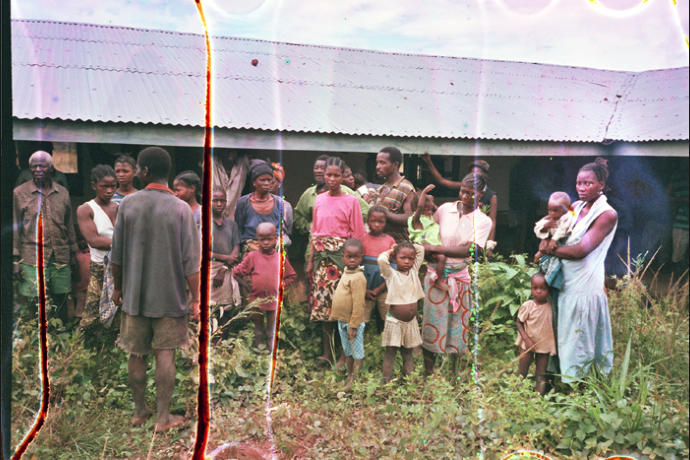












The magazine of the art-form of the photo-essay
“A free, really high quality photo-essay magazine. Fabulous!”
Stephen Fry. British actor, writer and film & documentary maker

July 2014 back issue

photographs by James Brabazon
words by Max Houghton


Photographers frame war in all its vivid chaos and carnage. Its long-term effects are harder to picture and easier to
forget.
At the height of the second Liberian civil war in 2002, James Brabazon was the only journalist with access to the
territory in northern Liberia controlled by Liberians United for Reconciliation and Democracy (LURD) as they tried to
oust President Charles Taylor. His self-directed brief was to prove the existence of the rebels, and, in so doing, alert
the world to the gravity of the situation in West Africa.
Filming the LURD soldiers necessitated entering Liberia illegally via Guinea, undertaking a gruelling two and a half day
walk through thick jungle, in 95% humidity and temperatures approaching 40°C, culminating in crossing the River Via
on foot. The raging water swallowed two cases of the rebels’ mortar bombs, a pallet of their ammunition, and a bag of
Brabazon’s medical supplies, as well as seeping into his stills camera, loaded with 35mm colour negative film.
In publishing these water-damaged images twelve years later, many more stories coalesce on their scarred surfaces.
When film gets wet, it is the gelatine layer of the film, where the image is stored, that is most susceptible to distortion.
This is a layer so infinitesimally thin, it would not be visible to the naked eye. There is a certain irony in the fact that
the look of these ruined pictures is so authentic, one suspects the application of sophisticated after-effects software.
‘Authenticity’ is a desirable commodity, especially in the art world; indeed it can transform a set of images from
journalism into feted art, as, perversely, can the passing of time. Similarly, ‘vintage’ is a style, or a look, often applied
intentionally, afterwards, as opposed to referring to a time when something of quality was produced.
However, the desire to make work that is remembered beyond its time (whether or not this makes it art?) is laudable.
In the West, we hear of Liberia only in times of war or deadly disease outbreak. If accidentally-damaged photographs
give us a reason to look back, to engage in the kind of remembrance so well understood by former service men and
woman in the World Wars, it is surely better than not looking at all.
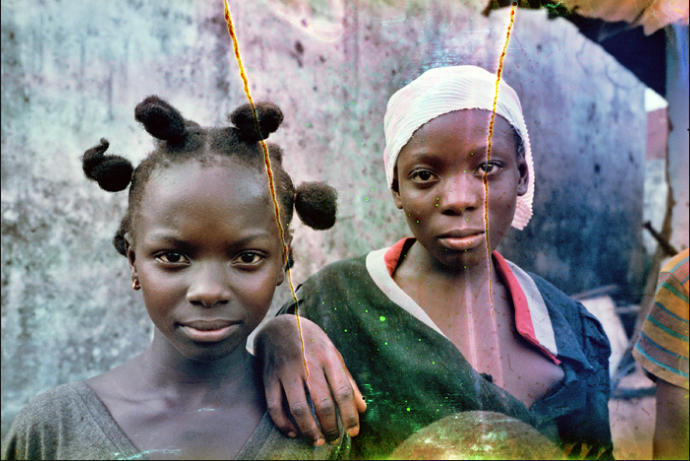
A red and yellow tributary sears the left temple of one young girl; the eye of another. War dictates they will think and
see differently from now on. We do not know if these girls in particular were forced to marry soldiers or if they were
brutalised or raped as many of their compatriots were during the warfare. It’s likely they had been assigned to a rebel
commander, for cooking duties at least, and to take care of younger children, displaced or orphaned by fighting.
Whether sexual services were obligatory is not known; that they would have had no agency over their sexual
destinies is certain. The almost-revealed nipple of the pre-pubescent girl is, perhaps, a portent.
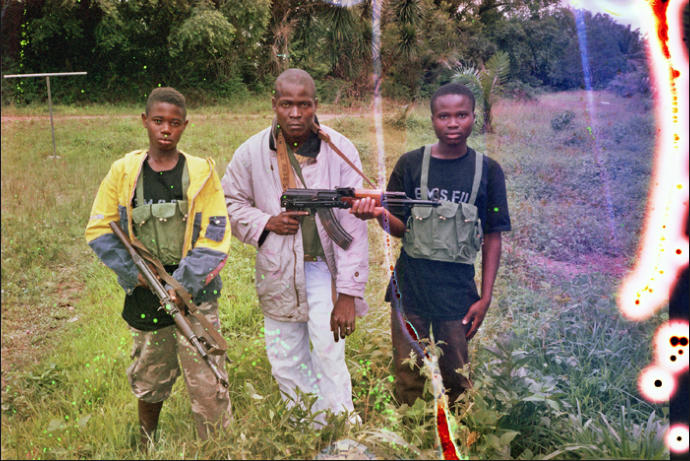
The photograph of three young men with guns is the kind of image often taken out-of-context by mainstream media.
Child soldiers, they shriek. They may well be; but in the specifics of this war, it was Charles Taylor who recruited boys
as such; boys who now, as grown men (those that survived) miss their Papeh viscerally. The LURD rebel commanders
habitually used ‘pekin’, young boys, usually displaced or orphaned, to carry weapons or ammo, to run and fetch, in e
xchange for ‘protection.’ At the age of twelve or fourteen, they graduate to fighter status. The water damage in this
image has undergone a phase change and has transformed into fire; its flames threatening to encircle these young
men, licking the edges of the frame. At the time, in Zorzor, Brabazon took this as pacification photograph; wisely
keeping gunmen on side. The two younger boys are wearing Executive Mansion Strike Force Unit t-shirts, so it is likely
they have just acceded to the group of fighters who protect the leader. The real executive mansion was of course the
presidential compound occupied by Taylor, at least until August of the following year, when the LURD’s presence in
Monrovia became life-threatening, and he fled to Nigeria. There would have been long odds on his ending up in a jail
in northern England, a decade on, claiming a breach of his human rights.
A lone man on a sat-phone in a field at night-time in Zolowo, is Dudley Saunders; now dead. He came on board in
Liberia as cameraman, but, along with soundman Mandla Mlambo, was forced to turn back owing to ill health and
other professional commitments as soon as the small crew arrived in Fassama – three weeks into the assignment.
Liberia didn’t kill Saunders, but journalism did. He was filming a story in his native South Africa, when he was struck
by a train in Soweto. No-one, apparently, was watching his back. In that Liberian field, it looks as though a strange,
southern aurora borealis was offering him a protective halo. It didn’t last.
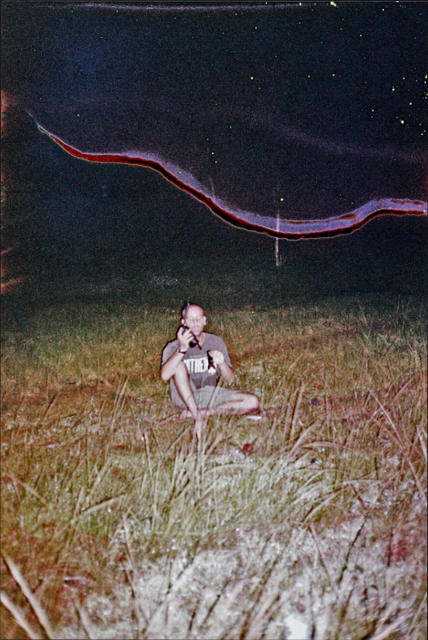
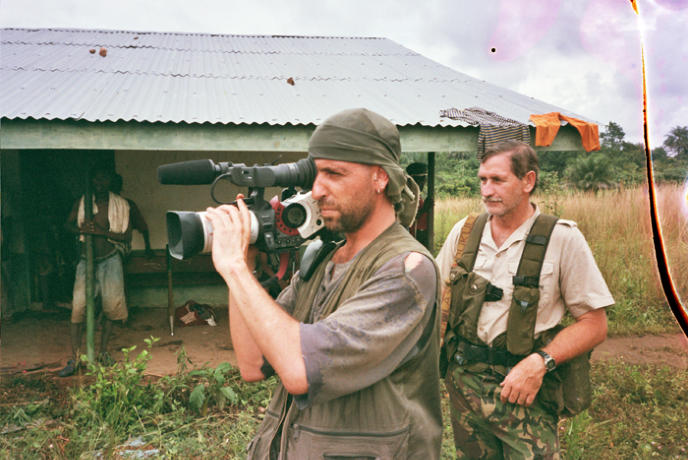
Saunders is also present, camera on shoulder, in another image – filming the displaced civilians who stand listlessly
around the rebel base at Zolowo waiting for payment in cigarettes and salt to carry weapons and supplies to the
frontline for the young fighters. In the damaged photograph Brabazon takes of the scene Saunders is filming, the
image is lacerated by black vertical rents separating the family groups, cleaving the men away from the women and
children.
Just behind Saunders stands the man Brabazon calls My Friend the Mercenary in his eponymous memoir of this
extraordinary time. He is Nick du Toit, a South African former Special Forces Lieutenant Colonel and mercenary
commander, secured by Brabazon as his de facto bodyguard in order to carry out his highly unusual, journalistic
mission. In this image, the men are at a crossroads, which they were, symbolically as well as physically. It was from
this point on that the journey would become much more dangerous, as they travelled deeper into Liberia, to film rebels
and warfare. Du Toit would then go on to attempt the infamous coup in Equatorial Guinea, with Simon Mann and Mark
Thatcher, in 2004. Their ultimate failure saw du Toit committed to the notorious Black Beach jail for nearly six years
where he was tortured, starved and kept in a 5ft x 7ft cell. He was pardoned in 2009.
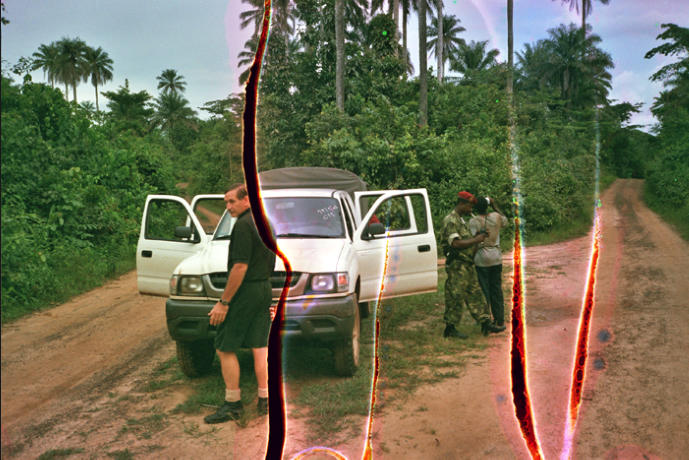
The other picture here in which du Toit features, the water damage caresses his form like vertical lightning, giving him
and the image a palpable charge. Bengura, the Guinean soldier in the red beret, was assigned to Brabazon, du Toit et
al, but was more usually employed as the driver to the then President of Guinea, Lanana Conte , and also as the
driver of the leader of the rebels, Sekou Connneh. Here, Bengura looks as though he is walking into the fire. LURD is
now officially defunct, but as recently as May 2014 Conneh told AFP that ex-combatants are ready to ferment trouble,
disillusioned by their lack of status, unemployment, and, without a genocidal warlord to unseat, purposelessness. Even
in its absence, war’s destruction abides.
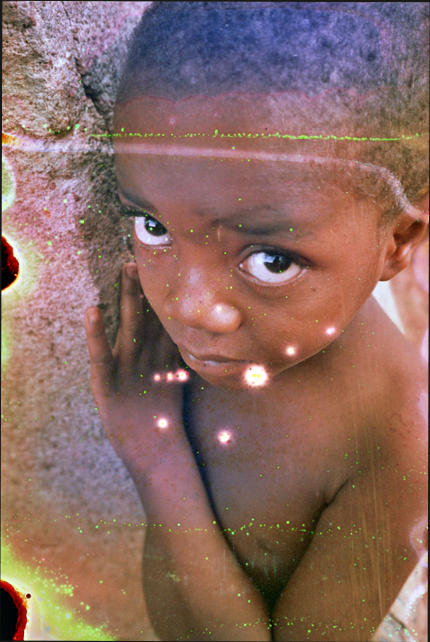
Perhaps the most poignant images here are those featuring the very young child, looking up into the camera lens,
luminous eyes full of fear. At this frozen moment in time, it is likely the fright was sparked by a huge white man with a
camera. Local folklore conjures white ghosts from the forest, who spirit children away. This legacy of the slave trade is
a real source of terror for Liberian children even today; many children in northern rebel-held Liberia had not
encountered a white face in infancy – cut off as their communities were during the war.
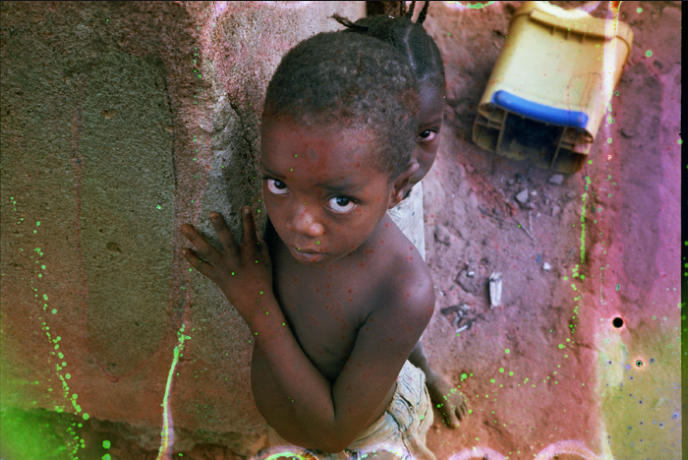
In one picture, the child is shadowed by another tiny girl. Red and green dots on skin – the damage – create an
abstract pointillism that invokes another thread of narrative, a spider story, narrated by du Toit in Brabazon’s book:
‘I knew this guy in the army. He got bitten. It was a strange wound and we couldn’t figure out what the hell it was.
There was this little circle of red dots, and the skin in the middle just wouldn’t heal. One day, when we thought it was
getting better, it just collapsed into a hole in his thigh, completely rotten. He nearly lost his leg. That’s a fokken spider
bite for you. Better leave them alone.’
Journalistically, this trip was a success. Brabazon’s short documentary film Journey Without Maps was shown on news
networks worldwide, and subsequently won the Rory Peck Impact Award 2003.
But there is something extraordinary about this set of images, published here for the first time. It’s not a carefully
constructed, linear trajectory, focusing on passive victims or heroic fighters; instead we understand a little of the
process of war. But more than that, through these damaged images, the process of story-telling itself is made manifest.
All the characters come to life; some to death. And the moral of the story is … there isn’t one, as Tim O’Brien also
knew, writing in The Things They Carried:
‘A true war story is never moral. It does not instruct, nor encourage virtue, nor suggest models of proper human
behavior, nor restrain men from doing the things men have always done. If a story seems moral, do not believe it. If at
the end of a war story you feel uplifted, or if you feel that some small bit of rectitude has been salvaged from the larger
waste, then you have been made the victim of a very old and terrible lie […]
‘And in the end, of course, a true war story is never about war. It's about sunlight. It's about the special way that dawn
spreads out on a river when you know you must cross the river and march into the mountains and do things you are
afraid to do. It's about love and memory. It's about sorrow. It's about sisters who never write back and people who
never listen.’

